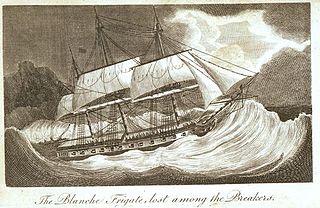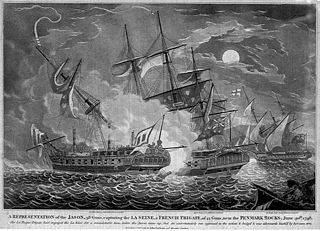
Guerrière was a 38-gun frigate of the French Navy, designed by Forfait. The British captured her and recommissioned her as HMS Guerriere. She is most famous for her fight against USS Constitution.

HMS Astraea was a 32-gun fifth rate Active-class frigate of the Royal Navy. Fabian at E. Cowes launched her in 1781, and she saw action in the American War of Independence as well as during the Napoleonic Wars. She is best known for her capture of the larger French frigate Gloire in a battle on 10 April 1795, while under the command of Captain Lord Henry Paulet. She was wrecked on 23 March 1808 off the coast of Anegada in the British Virgin Islands.
The Sea Fencibles were naval fencible units established to provide a close-in line of defence and obstruct the operation of enemy shipping, principally during the French Revolutionary and Napoleonic Wars.
There have been a number of Royal Navy ships called HMS Brazen
HMS Lively was a 32-gun fifth-rate Alcmene-class frigate of the British Royal Navy launched on 23 October 1794 at Northam, Devon. She took part in three actions one a single-ship action, one a major battle, and one a cutting-out boat expedition – that would in 1847 qualify her crews for the issuance of the Naval General Service Medal. Lively was wrecked in 1798.
HMS Boadicea was a frigate of the Royal Navy. She served in the Channel and in the East Indies during which service she captured many prizes. She participated in one action for which the Admiralty awarded the Naval General Service Medal. She was broken up in 1858.

HMS Amfitrite was a 38-gun fifth-rate frigate of the Royal Navy. She had previously served with the Spanish Navy before she was captured during the Napoleonic Wars and commissioned into the Royal Navy. The Admiralty renamed her HMS Blanche after she had spent just over a year as Amfitrite. She was the only ship in the Navy to bear this specific name, though a number of other ships used the conventional English spelling and were named HMS Amphitrite. Her most notable feat was her capture of Guerriere in 1806. Blanche was wrecked in 1807.
Vénus was a corvette of the French Navy that the British captured in 1800. Renamed HMS Scout, she served briefly in the Channel before being wrecked in 1801, a few days after taking a major prize.

HMS Martin was a 16-gun sloop of the Royal Navy. She served at the Battle of Camperdown in 1797 and captured two privateers before she disappeared in 1800.

Seine was a 38-gun French Seine-class frigate that the Royal Navy captured in 1798 and commissioned as the fifth-rate HMS Seine. On 20 August 1800, Seine captured the French ship Vengeance in a single ship action that would win for her crew the Naval General Service Medal. Seine's career ended in 1803 when she hit a sandbank near the Texel.

HMS Persian was a Cruizer-class brig-sloop built by Daniel List and launched at Cowes in 1809. She captured two privateers before she wrecked in 1813.
HM hired brig Telegraph was built in 1798 and served on contract to the Royal Navy from 10 November. During the French Revolutionary Wars she took several prizes and was the victor in one notable ship action before she was lost at sea with all hands in 1801.
HMS Alcmene was a 32-gun Alcmene-class fifth rate of the Royal Navy. This frigate served during the French Revolutionary and Napoleonic Wars under the command of several notable officers. Alcmene was active in several theatres of the war, spending most of her time cruising in search of enemy vessels or privateers, and escorting convoys. She fought at the Battle of Copenhagen in 1801 and served in the blockade of the French coasts during the later Napoleonic Wars until she was wrecked on the French coast in 1809.
HMS Alban was one of twelve Adonis-class schooners of the Royal Navy and was launched in 1806. She served during the Napoleonic Wars. During the Gunboat War she took part in two engagements with Danish gunboats, during the second of which the Danes captured her. The British recaptured her seven months later, but she was wrecked in 1812.

HMS Redbridge was one of four schooner-rigged gunboats built to an experimental design by Sir Samuel Bentham. Her launch date is unknown, but the Admiralty purchased her in April 1798. She had a short, relatively uneventful career before the French captured her in 1803. The French Navy sold her in January 1814.
HMS Pert was the French privateer Bonaparte, a ship built in the United States that HMS Cyane captured in November 1804. The Royal Navy took Bonaparte into service as HMS Pert. Pert was wrecked off the coast of what is now Venezuela in October 1807.
Several ships have been named John:
HMS Requin was the French Navy cutter Requin, launched at Boulogne in 1794. HMS Thalia captured Requin in 1795. Requin captured one small French privateer and participated in the capture of Suriname before wrecking in 1801.

HMS Jason was a 36-gun fifth-rate Penelope-class frigate, launched in 1800. She served the entirety of her career in the English Channel, mostly in the frigate squadron of Commodore Charles Cunningham. Serving off the coast of France, especially around Le Havre and Cherbourg, she captured several French privateers and recaptured a British merchant ship in a cutting out expedition. Having only been in commission for around fifteen months, Jason was wrecked off the coast of St Malo on 21 July 1801. Her crew were saved and later exchanged, and in August her wreck was burned to prevent the French from rescuing it.







